Immerse yourself in uncovering the hidden connections between biblical stories and their deeper meanings with types and antitypes.
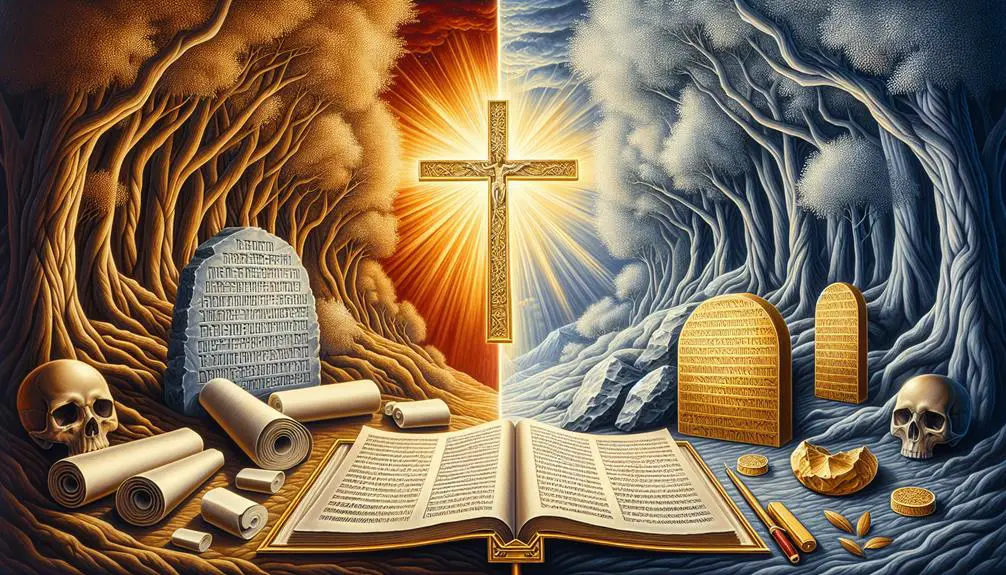
Types and Antitypes in the Bible
Nearly three-quarters of the Bible is composed of narratives, many of which scholars argue contain types and antitypes that reveal deeper spiritual truths.
You've likely come across these shadowy figures and events without even realizing their full significance. For instance, consider how Noah's ark is more than just a story of survival—it's seen as a prefiguration of salvation in Christianity.
If you're intrigued by how ancient texts can mirror future events or people, then exploring the concept of biblical typology will uncover layers of meaning you may have missed before.
What other familiar stories might hold hidden messages waiting to be uncovered?
Key Takeaways
- Typology in the Bible reveals deep connections between Old Testament events and New Testament fulfillments, enhancing narrative continuity and theological depth.
- Adam serves as a foundational type, with Jesus as the antitype, highlighting themes of sin, redemption, and the transformative grace of obedience.
- Old Testament stories like Noah's Ark and the Passover Lamb prefigure New Testament realities, demonstrating God's consistent plan for salvation.
- The legacy and kingdom of David serve as a type for the everlasting kingdom of Christ, symbolizing the transition from temporal to eternal sovereignty.
Understanding Biblical Typology
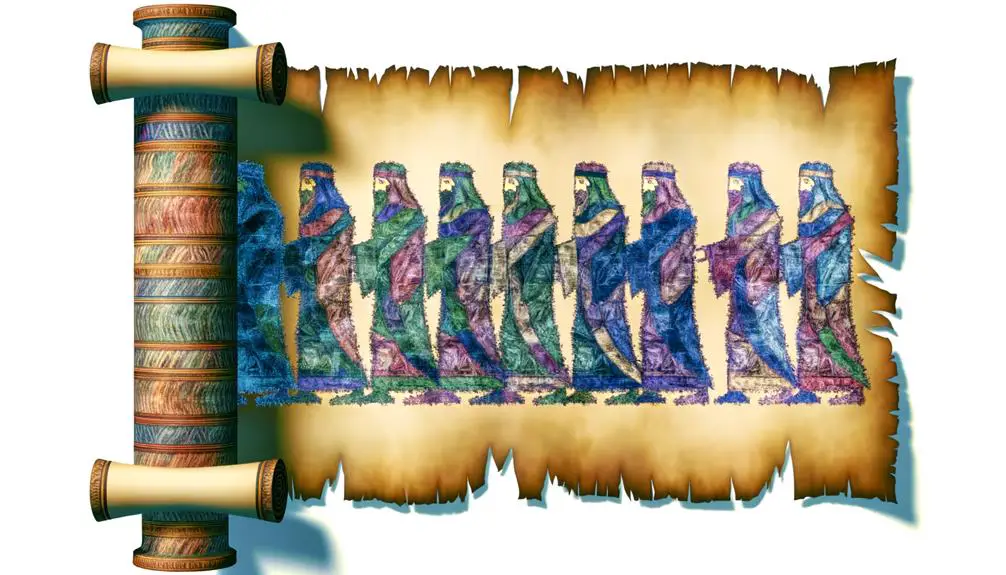
To grasp the concept of biblical typology, it's essential to understand that it involves identifying a relationship between Old Testament events, persons, or institutions (types) and their New Testament fulfillments or counterparts (antitypes). This method of typological interpretation uncovers the deep, symbolic parallels that underscore the continuity and unity within the Bible's narrative.
At its core, typology isn't merely about drawing simple comparisons; it's an intricate analytical tool that unveils the intentional design within the scriptures. You'll find that it's grounded in the belief that divine providence has orchestrated these historical events to foreshadow greater realities. Through this lens, seemingly isolated incidents in the Old Testament gain profound significance as precursors to New Testament revelations.
For instance, the Exodus, where Moses leads the Israelites out of Egyptian bondage, serves as a type for the ultimate redemption of humanity from sin, achieved through Christ's sacrifice – the antitype. Here, the typological interpretation doesn't hinge on superficial similarities but on the thematic resonance of deliverance and salvation that links both events.
Understanding typology requires a discerning eye for these symbolic parallels, which go beyond mere coincidence or literary motif. It demands a scholarly approach that appreciates the theological depth and the narrative craftsmanship of the biblical text. Engaging with typology, then, isn't just an exercise in tracing historical connections; it's an exploration of the intricate ways in which the divine narrative unfolds, revealing a masterful interweaving of type and antitype that enriches one's reading of the Bible.
The Significance of Adam

You must recognize Adam's foundational role in biblical narratives, where he emerges as the first man, intricately linked to the origination of sin.
This juncture in scripture paves the way for a profound comparison between Adam and Christ, highlighting a typological contrast that underpins much of Christian theology.
Analyzing these points offers insights into the mechanisms of sin and redemption, framing a pivotal discourse within biblical studies.
Adam as First Man
Why does Adam's role as the first man hold profound significance in biblical typology? Adam stands as a foundational figure in Scripture, not merely as the first of humankind but as a pivotal part of salvation history. The Genesis genealogies meticulously trace humanity back to Adam, underscoring his role in God's plan. Adam's lineage sets the stage for understanding humanity's place in the divine narrative.
Feature |
Significance in Typology |
Relation to Adam |
|---|---|---|
First Man |
Prototype of humanity |
Direct connection |
Genesis Genealogies |
Basis of biblical ancestry |
Source of lineage |
Role in Salvation History |
Forefather of God's people |
Ancestral significance |
Typological Significance |
Antitype of Christ |
Contrast in roles |
Through Adam, you grasp the interconnectedness of human history and divine purpose, marking him as a crucial typological figure.
Sin's Introduction Through Adam
Adam's transgression in the Garden of Eden marks a pivotal moment in biblical history, introducing sin into the world and altering humanity's relationship with the divine. This event carries profound implications, both genetic and cultural, that continue to resonate throughout human history.
- Genetic Consequences: Adam's sin introduced a hereditary flaw, a spiritual and moral corruption passed down through generations.
- Cultural Ramifications: This original sin has influenced societal norms and values, often manifesting in systemic issues of injustice and moral decay.
- Altered Divine Relationship: Humanity's inherent sinfulness necessitates a complex relationship with the divine, characterized by redemption and grace.
- Perpetual Struggle: The introduction of sin set the stage for an ongoing struggle between good and evil within the human heart and in society at large.
Christ Compared to Adam
While Adam's fall sowed the seeds of sin and separation, Christ's sacrifice offers a profound counterpoint, embodying redemption and the restoration of divine fellowship. This Grace Contrast between Adam and the Second Adam, Christ, is pivotal in understanding Christian theology.
Aspect |
Adam |
Christ |
|---|---|---|
Role |
First man |
Second Adam |
Action |
Disobedience |
Obedience |
Consequence |
Sin entered |
Sin atoned |
Result |
Death to all |
Life to all |
Analyzing this table, you'll notice the stark contrasts and the beautifully symmetrical redemption arc. Christ's obedience and sacrifice directly counter Adam's disobedience and its catastrophic effects, offering a clear, analytical framework for the redemptive work through grace.
Noah's Ark as a Foreshadow

In biblical typology, Noah's Ark serves as a profound antitype, foreshadowing salvation and the concept of being saved from impending judgment. This narrative, rich in symbolism, particularly through its animal symbolism and flood geography, offers a multifaceted look at redemption and divine protection.
Here are four key aspects where Noah's Ark acts as a foreshadow:
- Animal Symbolism: Each species aboard the Ark represents the diversity of life that's preserved through divine intervention. This mirrors the inclusivity of salvation, emphasizing that it's accessible to all of creation. The clean and unclean animals also prefigure the breaking down of barriers in the New Covenant, where distinctions that once separated people are abolished.
- Flood Geography: The encompassing nature of the floodwaters symbolizes the all-encompassing judgment of sin. Yet, the Ark floating above these waters illustrates being lifted above judgment through faith. This geographical aspect of the flood narrative highlights the concept of being set apart or sanctified amidst pervasive corruption.
- The Ark as Refuge: Just as the Ark was the only means of escape from the flood, it typifies Jesus as the singular refuge from the judgment of sin. Believers are invited to enter the 'Ark' of salvation through faith, securing their safety from eternal judgment.
- Covenant Significance: The covenant God establishes with Noah post-flood prefigures the New Covenant through Christ. Just as the rainbow was a sign of God's promise to never flood the earth again, the cross is the sign of the New Covenant, symbolizing redemption and the promise of eternal life without condemnation.
Through these elements, Noah's Ark profoundly foreshadows the Christian concept of salvation, emphasizing faith, divine mercy, and the promise of a new beginning.
Abraham's Sacrifice Interpreted
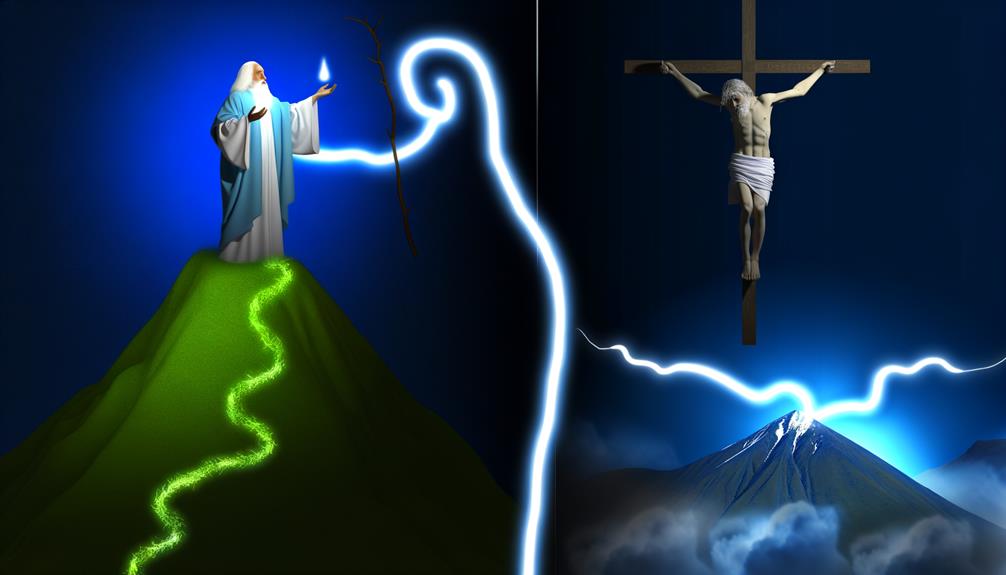
As you examine Abraham's sacrifice, you'll uncover rich layers of symbolism that foreshadow key New Testament themes.
Isaac, representing both promise and sacrifice, serves as a pivotal figure in understanding this profound narrative's broader theological implications.
This act, interpreted through New Testament lenses, reveals intricate typological connections, underscoring the sacrificial system's fulfillment in Christian doctrine.
Symbolism in Abraham's Test
To fully grasp the richness of Abraham's test, one must delve into the symbolic layers that reveal profound theological insights. The narrative isn't just a historical account but a reservoir of spiritual symbolism, particularly regarding the Mount Moriah mystery and Faith's dynamics. Here's a breakdown:
- Mount Moriah Mystery: Symbolizes the place of ultimate submission and divine provision, foreshadowing future sites of significant religious importance.
- Faith's Dynamics: Abraham's unwavering trust in God, despite the seeming absurdity of the request, highlights the depth and trial of faith.
- Ram in the Thicket: Represents divine intervention and a substitute for sacrifice, pointing to themes of redemption and salvation.
- The Journey: Symbolic of the believer's spiritual journey, characterized by obedience, testing, and eventual deliverance or revelation.
Analyzing these elements, one uncovers the intricate weave of faith, obedience, and divine provision embedded in Abraham's test.
Isaac: Promise and Sacrifice
Delving into the story of Isaac, one quickly recognizes him as both the embodiment of God's promise to Abraham and the central figure in a profound narrative of sacrifice and faith. This narrative isn't just about Abraham's faith but also intricately involves Rebekah's role, which later becomes crucial in the lineage through Esau's birth. Rebekah's influence and actions significantly impact the fulfillment of God's promises, indicating the complex dynamics within biblical families that contribute to God's broader plan.
Furthermore, Isaac's near sacrifice, halted by divine intervention, underlines a motif of faith tested and preserved, setting a precedent for understanding divine will and human obedience. The nuances of Isaac's story, including Rebekah's involvement and the implications of Esau's birth, enrich the tapestry of biblical typology, highlighting themes of promise, sacrifice, and providential guidance.
New Testament Fulfillment
The intricate narrative of Abraham's willingness to sacrifice Isaac, a seminal event in Old Testament theology, finds its profound echo and fulfillment in the New Testament through the sacrifice of Jesus Christ.
Here's how this pivotal moment translates and impacts the New Testament narrative:
- Prefigures Jesus' Sacrifice: Just as Isaac carried wood for his own sacrifice, Jesus bore His cross, highlighting obedience and submission.
- Demonstrates Ultimate Faith: Abraham's faith mirrors the faith required of Christians in the salvific power of Jesus' crucifixion.
- Foreshadows Gentile Inclusion: This act symbolizes the breaking down of barriers, paving the way for Gentile inclusion in salvation history.
- Catalyzes Church Formation: The event prefigures the formation of the Church, built on faith in Jesus' ultimate sacrifice, fulfilling God's promise to Abraham.
Moses: A Deliverer's Shadow
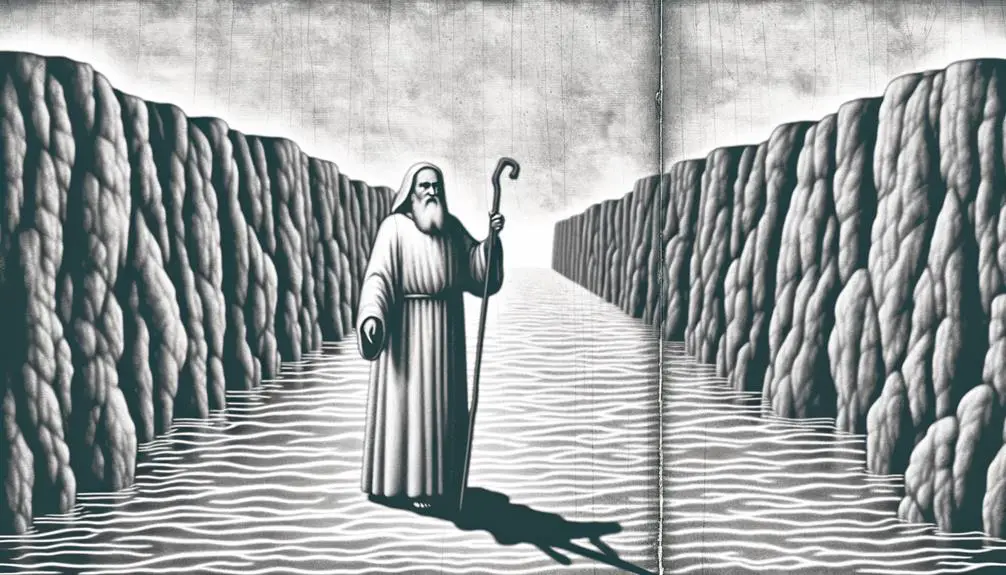
Moses serves as a profound archetype of deliverance, his life and actions casting a long shadow over the concept of liberation in biblical narratives. You'll notice that Moses' legislation, heavily influenced by his time in Egypt, meticulously lays the groundwork for Israel's societal and spiritual structure. This legislation not only governed the Israelites' daily lives but also set them apart from surrounding nations, symbolizing a physical and spiritual deliverance.
Aspect of Moses' Life |
Significance in Deliverance |
|---|---|
Escape from Egypt |
Marks the physical liberation from bondage, prefiguring spiritual freedom. |
Receiving the Law |
Establishes a covenant, signifying a divine deliverance from societal chaos and moral ambiguity. |
Leading to the Promised Land |
Embodies the journey from slavery to the fulfillment of God's promises, a metaphor for spiritual salvation. |
Analyzing Moses' influence, it's clear his life was a template for future deliverance narratives. His legislation, while influenced by Egyptian culture, was revolutionary in its monotheism and ethical standards. This Egyptian influence, contrasted with the divine inspiration Moses received, showcases a blend of cultural and spiritual liberation. Moses' role as a deliverer wasn't just about leading Israel out of physical bondage in Egypt; it was also about establishing a new identity for them, one rooted in the laws and teachings that would differentiate them from other nations and guide them towards a promised future.
Moses' story, therefore, is not just historical; it's a theological blueprint for understanding the nature of deliverance, both physically and spiritually, in the Bible.
The Passover Lamb Explained

As we explore further, it's essential to understand how the Passover lamb serves as a quintessential antitype of salvation and deliverance, mirroring the broader themes of liberation found within the biblical narrative. The selection and sacrifice of the Passover lamb, and the subsequent feast rituals, underscore the profound symbolism embedded in this ancient practice.
- Lamb Selection: The meticulous criteria for selecting the Passover lamb—unblemished, male, and of a year old—emphasize the purity and perfection required for an offering that symbolizes deliverance. This selection process isn't merely about adhering to ritualistic standards; it's a profound reflection of seeking the ideal, a metaphor for spiritual purity and redemption.
- Feast Rituals: The rituals surrounding the Passover feast, including the consumption of unleavened bread and bitter herbs, are laden with symbolism. They're not arbitrary culinary choices but intentional acts designed to evoke the memory of haste and bitterness of slavery, fostering a collective remembrance of deliverance.
- Blood Application: The act of applying the lamb's blood to the doorposts is a vivid antitype of protection and salvation. It's a physical manifestation of faith, marking the households that would be passed over by the plague of the firstborn—a powerful symbol of divine deliverance.
- Commemoration Command: The command to annually commemorate the Passover serves as a perpetual reminder of liberation and the covenant between the divine and the faithful. It's a ritual re-enactment of deliverance, ensuring that the memory of liberation and the principles of faith, obedience, and gratitude are perpetually instilled in future generations.
In dissecting the Passover lamb's role, one uncovers layers of typology that highlight the intricate relationship between historical events and their spiritual implications, reinforcing the theme of deliverance that permeates the biblical narrative.
David's Throne and Legacy

Exploring David's throne and legacy reveals a profound antitype within biblical narratives, embodying the transition from temporal authority to an everlasting kingdom. David's reign, marked by its establishment in Jerusalem, not only solidifies Jerusalem's significance but also prefigures the eternal rule promised in Christian eschatology. His legacy, through Solomon's wisdom and the construction of the Temple, emphasizes the shift from a physical dominion to a more spiritual governance.
David's rule in Jerusalem sets a precedent, making the city not just a political capital but a spiritual center. This move highlights Jerusalem's significance as not only the heart of David's kingdom but also as a symbol of the divine presence among people. Solomon, inheriting this legacy, embodies wisdom and understanding, traits that further the kingdom's prosperity and serve as a metaphor for divine insight and judgment.
The following table contrasts key aspects of David's reign and legacy with their antitypical significances:
Aspect of David's Reign |
Antitypical Significance |
|---|---|
Establishment in Jerusalem |
Symbolizes eternal kingdom |
Solomon's wisdom |
Embodies divine insight |
Construction of the Temple |
Shift from physical to spiritual dominion |
Transition from temporal authority |
Prefigures everlasting rule |
This analysis underscores the intricate layering of types and antitypes within the biblical text, inviting you to delve deeper into the scriptures to uncover the rich tapestry of meaning that spans from historical events to their spiritual and eschatological implications. David's throne and legacy, thus, serve as a crucial junction, bridging temporal authority and an envisioned eternal kingdom.
Jonah's Ordeal and Message
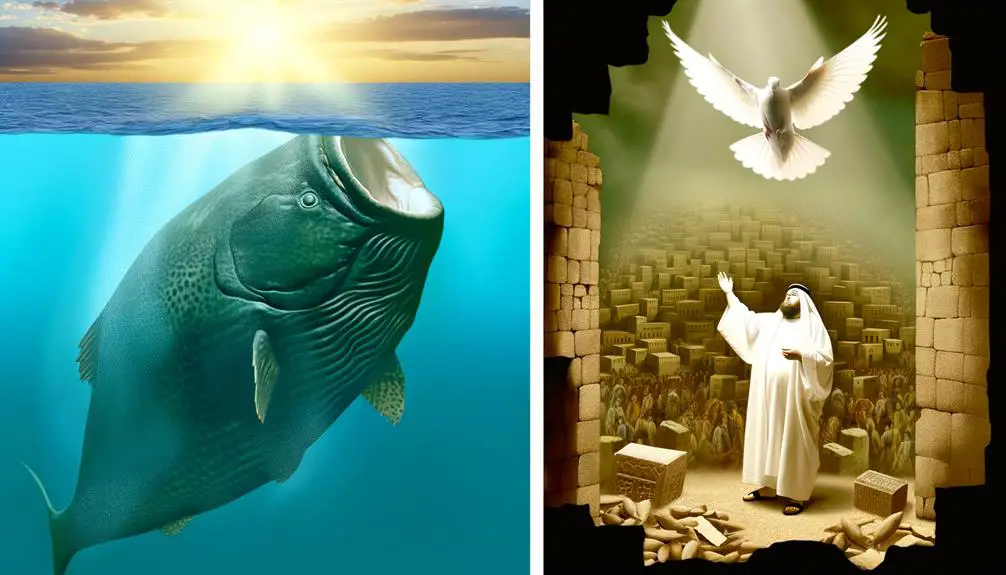
Turning our attention to Jonah's ordeal and message, we encounter a narrative deeply interwoven with themes of repentance, divine mercy, and human agency. The story of Jonah isn't merely an account of maritime survival but a profound exploration of human reluctance versus divine commissioning.
Jonah's flight from God's command to preach to Nineveh, his subsequent maritime ordeal, and the city's eventual repentance offer a rich tapestry for analysis. Here are four critical aspects of this narrative:
- Divine Commissioning: Jonah's initial refusal to go to Nineveh underscores the tension between divine will and human agency. This act of disobedience sets the stage for his maritime ordeal, illustrating the consequences of attempting to flee from divine responsibilities.
- Maritime Survival: The storm and Jonah's time in the belly of the great fish aren't just dramatic elements of survival but symbolize the process of inner transformation. This ordeal serves as a metaphor for rebirth, crucial for Jonah's subsequent compliance with God's command.
- Nineveh's Repentance: The heart of Jonah's message to Nineveh is the potential for divine mercy upon genuine repentance. Nineveh's wide-scale repentance illustrates the power of prophetic warning and the possibility of redemption, even for the most wayward.
- Divine Mercy and Human Agency: The narrative culminates in a demonstration of divine mercy, not just towards Nineveh but also towards Jonah. It explores the complexity of human emotions and divine purposes, highlighting the possibility of second chances.
In analyzing Jonah's ordeal and message, we delve into a story rich with theological and moral implications, emphasizing the interplay between divine mercy, human failure, and redemption.
Frequently Asked Questions
How Does the Concept of Types and Antitypes Impact Modern Christian Theological Debates, Particularly Regarding Eschatology and Soteriology?
You're diving into how theological debates, especially around eschatology and soteriology, are influenced. This exploration involves divine sovereignty and predestination debates, crucial elements in understanding modern Christian thought.
Are There Any Non-Biblical Religious Texts or Traditions That Mirror the Typological Structures Found in the Bible, Suggesting a Broader Cultural or Historical Pattern of Typological Thinking?
You're diving into how mythological parallels and cultural symbolism in non-biblical traditions may echo biblical typology, showing a widespread pattern of thought.
Interestingly, over 80% of world mythologies exhibit some form of typological structure, highlighting its universal appeal.
Analyzing these parallels, you'll find that many traditions utilize typology to convey deep truths, suggesting a shared human inclination towards using symbolic narratives to understand the world and our place within it.
In What Ways Have Contemporary Biblical Scholars Critiqued or Expanded Upon Traditional Interpretations of Types and Antitypes, Especially in Light of New Archaeological Findings or Historical Research?
In examining how scholars critique or expand upon traditional views, you'll find they've leveraged archaeological methodologies and historical revisionism significantly. They've dug into ancient texts and artifacts, challenging old interpretations and proposing new connections.
This approach has reshaped understanding, emphasizing context and cultural influences over mere theological assertions. It's a dynamic field, where each discovery can potentially alter the narrative, making you rethink what you thought was set in stone.
How Do Different Christian Denominations Vary in Their Interpretation and Emphasis on Certain Biblical Types and Their Corresponding Antitypes, and What Does This Say About Their Theological Priorities?
You're navigating a forest of beliefs, where each path—marked by liturgical practices and shaped by ecumenical dialogues—reveals how Christian denominations vary in interpreting biblical symbols.
This diversity isn't just about differing viewpoints; it highlights their theological priorities.
As you delve deeper, you'll find that these variations in emphasis on certain biblical figures and events reflect a broader spectrum of understanding, enriching the collective faith journey with multiple layers of meaning and interpretation.
Can the Concept of Types and Antitypes Be Applied to Understand the Narratives of Non-Religious Texts or in the Analysis of Literary Works, and if So, What Are Some Notable Examples?
Absolutely, you can apply the concept of types and antitypes to understand narratives in non-religious texts, especially when exploring literary symbolism and narrative parallels. This analytical approach reveals deeper meanings and connections across various works.
Notable examples include the parallels between Homer's Odysseus and Joyce's Leopold Bloom in 'Ulysses,' where Bloom's journey mirrors Odysseus's, showcasing modern trials against ancient heroism, enriching the text's layers and thematic depth.
Conclusion
As you've journeyed through the rich tapestry of biblical typology, you've encountered the profound connections between figures like Adam, Noah, and Moses, and their greater fulfillments in spiritual truths.
Consider the intricate pattern of a spider's web, where each thread is purposefully placed to support the whole structure. Similarly, types and antitypes in the Bible weave together to form a cohesive narrative of redemption and hope, inviting you to marvel at the meticulous design behind these sacred texts.


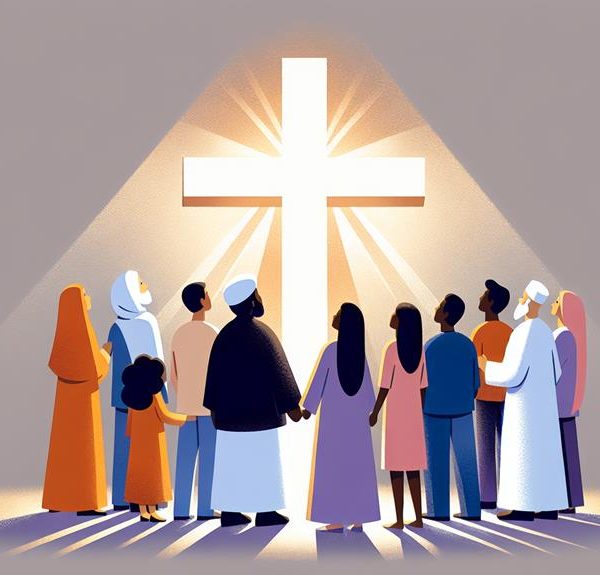
Sign up